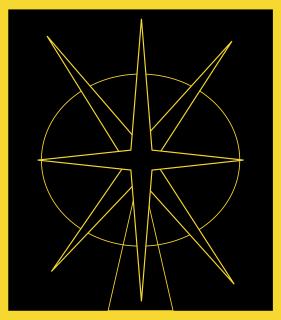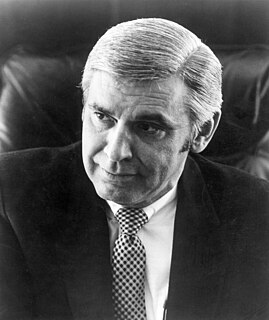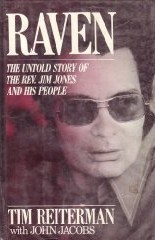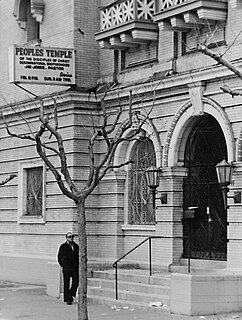Related Research Articles
The history of Guyana begins about 35,000 years ago with the arrival of humans coming from Eurasia. These migrants became the Carib and Arawak tribes, who met Alonso de Ojeda's first expedition from Spain in 1499 at the Essequibo River. In the ensuing colonial era, Guyana's government was defined by the successive policies of Spanish, French, Dutch, and British settlers.

The Peoples Temple of the Disciples of Christ, commonly shortened to Peoples Temple, was an American new religious organization which existed between 1954 and 1978. Originally founded in Indianapolis, Indiana, by Reverend Jim Jones, the Peoples Temple spread a message that combined elements of Christianity with communist and socialist ideology, with an emphasis on racial equality. After Jones moved the group to California in the 1960s and established several locations throughout the state, including its headquarters in San Francisco, the Temple forged ties with many left-wing political figures and boasted 20,000 members.

The Peoples Temple Agricultural Project, better known by its informal name "Jonestown", was a remote settlement in Guyana, established by the Peoples Temple, a San Francisco-based cult under the leadership of Jim Jones.

James Warren Jones was an American cult leader, political activist, preacher and faith healer who led the Peoples Temple, a new religious organization which existed between 1955 and 1978. He was known for his advocacy of Stalinism and Marxism. Jones and his inner circle orchestrated a mass murder–suicide in his remote jungle commune at Jonestown, Guyana, on November 18, 1978.

Leo Joseph Ryan Jr. was an American teacher and politician. A member of the Democratic Party, he served as the U.S. Representative from California's 11th congressional district from 1973 until his assassination during the Jonestown massacre in 1978. Before that, he served in the California State Assembly, representing the state's 27th district.
Brindley Horatio Benn, CCH was a teacher, choirmaster, politician, and one of the key leaders of the Guyanese independence movement. He was put under restriction when the constitution was suspended in 1953. In 1957, Benn served as Minister of Community Development and Education in the first elected government of Guyana, and between 1961 and 1964 as Minister of Natural Resources. From 1993 to 1998, he served as High Commissioner of Guyana to Canada.
Mass suicide is a form of suicide, occurring when a group of people simultaneously kill themselves.
Don Harris was an NBC News correspondent who was killed after departing Jonestown, an agricultural commune owned by the Peoples Temple in Guyana. Harris and four others were killed by gunfire by Temple members at a nearby airstrip in Port Kaituma, Guyana. Their murders preceded the death of 909 Temple members in Jonestown and four Temple members in Georgetown, Guyana.

Charles R. Garry was an American civil rights attorney who represented a number of high-profile clients in political cases during the 1960s and 1970s, including Huey P. Newton during his 1968 capital murder trial and the Peoples Temple during the 1978 Jonestown tragedy.

Guyana Tragedy: The Story of Jim Jones, also called The Mad Messiah, is a 1980 television miniseries about the Peoples Temple led by Jim Jones, and their 1978 mass suicide at Jonestown. Based on the book by Charles A. Krause, entitled Guyana Massacre: The Eyewitness Account, the film was originally shown on television on April 15, 1980.
Jeannie Mills, formerly Deanna Mertle, was an early defector from the Peoples Temple organization headed by Jim Jones. With her husband and Timothy Stoen, she co-founded the Concerned Relatives of Peoples Temple Members organization in 1977. Mills was murdered in 1980 along with her husband and one of her daughters, in a killing which remains unsolved.
Black & White is a non-fiction book written by Shiva Naipaul and published by Hamish Hamilton in the U.K. in 1980. It was published with the title Journey to Nowhere: A New World Tragedy in the U.S. The book is based on Naipaul's trip to Guyana in the aftermath of the Jonestown Massacre, and his subsequent trip to the United States, in which he explored links between the People's Temple and other groups and individuals. Naipaul attempted to connect Rev. Jim Jones, founder of the People's Temple, with disparate parts of California's counterculture, and Guyanese and other Third World governments and the revolutionary ideologies which supported them. Naipaul was highly critical of these and other movements, including black theology, the nascent New Age movement and EST, in as much as they helped, in his analysis, to create fertile ground for the People's Temple to flourish on the two continents. The book's US paperback cover tagline reads "How American ideas and ideologies led to the mass suicide of 900 people in Jonestown, Guyana."

Guyana: Crime of the Century is a 1979 Mexican-American exploitation drama film written and directed by René Cardona Jr.. The film, which was shot in Mexico, is based on the Jonestown Massacre. It stars a number of American actors such as Stuart Whitman, Gene Barry and Joseph Cotten. The names of central characters are slightly tweaked from the historical ones: the film is set in "Johnsontown" rather than Jonestown, the cult is led by "Reverend James Johnson" (Whitman) rather than Rev. Jim Warren Jones, and the murdered Congressman is "Lee O'Brien" (Barry) rather than Leo Ryan.

Raven: The Untold Story of the Rev. Jim Jones and His People details the life and ultimate demise of Jim Jones and the Peoples Temple. Written by journalist Tim Reiterman, the book reviews the history of the Peoples Temple. The book includes numerous interviews, audio tapes and documents among its hundreds of sources.
Timothy Oliver Stoen is an American attorney best known for his central role as a member of the Peoples Temple, and as an opponent of the group during a multi-year custody battle over his six-year-old son, John. The custody battle triggered a chain of events which led to U.S. Representative Leo Ryan's investigation into the Temple's remote settlement of Jonestown in northern Guyana, which became internationally notorious in 1978 after 918 people—including Stoen's son—died in the settlement and on a nearby airstrip. Stoen continues to work as a deputy district attorney in Mendocino County, California, where he is assigned to the District Attorney's Fort Bragg office.

The Peoples Temple, the new religious movement which came to be known for the mass killings at Jonestown, was headquartered in San Francisco, California, United States from the early to mid-1970s until the Temple's move to Guyana in 1977. During this period, the Temple and its founder, Reverend Jim Jones, rose to national prominence thanks to Jones' interest in social and political causes, and wielded a significant amount of influence in San Francisco's city government.
"Drinking the Kool-Aid" is an expression used to refer to a person who believes in a possibly doomed or dangerous idea because of perceived potential high rewards. The phrase often carries a negative connotation. It can also be used ironically or humorously to refer to accepting an idea or changing a preference due to popularity, peer pressure, or persuasion. In recent years it has evolved further to mean extreme dedication to a cause or purpose, so extreme that one would "drink the Kool-Aid" and die for the cause.

The Liberator Party was a right-wing political party in Guyana.
The Progressive Youth Organisation of Guyana is a youth organisation in Guyana, the youth wing of the People's Progressive Party. The membership of Progressive Youth Organisation (PYO) is predominately Indo-Guyanese, like its mother party.
Carolyn Louise Moore Layton was a leadership figure within Peoples Temple and a long-term partner of Temple leader Jim Jones. Along with other inner circle members, she assisted in the planning of the mass murder-suicide that took place in Jonestown, Guyana on November 18, 1978. She was the mother of a child by Jones, Jim Jon "Kimo" Prokes.
References
- 1 2 3 Ameringer, Charles D. (1992). Political parties of the Americas, 1980s to 1990s: Canada, Latin America, and the West Indies. Greenwood Publishing Group. p. 356. ISBN 978-0-313-27418-3.
- ↑ Abraham, Sara (2007). Labour and the multiracial project in the Caribbean: its history and its promise. Lexington Books. pp. 117–118. ISBN 978-0-7391-1686-9.
- ↑ Mars, Perry. Ideology and change : the transformation of the Caribbean left. Detroit: Wayne State University Press, 1998. p. 185
- ↑ Canterbury, Dennis C.. Neoliberal democratization and new authoritarianism. Aldershot: Ashgate, cop. 2005. p. 117
- 1 2 3 Reiterman, Tim; Jabobs, John (2008). Raven: The Untold Story of the Rev. Jim Jones and His People. Penguin Books. pp. 412–413. ISBN 978-1-58542-678-2.